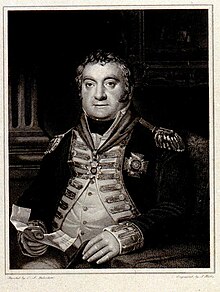Lord Amelius Beauclerk
| Lord Amelius Beauclerk | |
|---|---|

Admiral Lord Amelius Beauclerk, 1771–1846, by C J Robertson, engraved by S Watts
|
|
| Born | 23 May 1771 |
| Died |
10 December 1846 (aged 75) Winchfield House, near Farnborough, Hampshire |
| Allegiance |
|
| Service/branch |
|
| Years of service | 1782–1846 |
| Rank | Admiral |
| Commands held |
HMS Nemesis HMS Juno HMS Dryad HMS Fortunée HMS Majestic HMS Saturn HMS Royal Oak Commander-in-Chief at Lisbon Commander-in-Chief at Plymouth |
| Battles/wars | Napoleonic Wars |
| Awards | Colonel of Marines Knight Grand Cross of the Order of the Bath Knight Grand Cross of the Royal Guelphic Order Fellow of the Royal Society |
Admiral Lord Amelius Beauclerk GCB GCH FRS (23 May 1771 – 10 December 1846) was a British Royal Navy officer.
Beauclerk was born on 23 May 1771, the third son of Aubrey Beauclerk, 5th Duke of St Albans (1740–1802) and his wife, the former Lady Catherine Ponsonby (1742–1789), daughter of William Ponsonby, 2nd Earl of Bessborough. He was baptised at St Marylebone Parish Church, London on 15 June 1771.
He was entered on the books of the cutter Jackal in June 1782, and in 1783 was appointed to Salisbury, bearing the flag of Vice-Admiral John Campbell on the Newfoundland station. Afterwards he served in the West Indies under Commodore Gardner, and returned to England in 1789 as acting Lieutenant of Europa. He was not confirmed as a Lieutenant until 21 September 1790, at the time of the Great Spanish Armament crisis.
In 1792 he went to the Mediterranean in the frigate Druid, and on 16 September 1793 was made captain by Lord Hood and appointed to the command of Nemesis (28 guns). In March 1794 he was transferred to Juno (32 guns), and attached to the squadron under Admiral Hotham, blockading Toulon. Juno took part in the action of 14 March 1795, which resulted in the capture of the French ships Ça Ira and Censeur, and was one of the squadron, under Commodore Taylor, which convoyed the homeward trade in the following autumn, when the Censeur was recaptured by the French off Cape St Vincent on 7 October 1796.
...
Wikipedia
